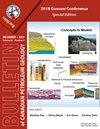基于碎屑锆石U-Pb定年的戴维斯海峡和拉布拉多海古新世和白垩系碎屑沉积岩物源研究
Q3 Earth and Planetary Sciences
引用次数: 2
摘要
拉布拉多陆架和戴维斯海峡的白垩系—古新世地层由碎屑沉积岩和火山岩组成,其中一些地层被认为是可能的油气储集层。利用LA-ICP-MS研究了位于Davis海峡和拉布拉多陆架9口不同井的碎屑锆石U-Pb物源分布,以评价沉积物的扩散模式和潜在储层的分布。分析了中白垩统Bjarni组、上白垩统Markland组和古新统Cartwright组的样品。根据U-Pb物源资料,将Bjarni组划分为北部和南部沉积区。北部以3000 Ma和3200 Ma锆石为主,主要来自Hopedale地块;相比之下,南部地区主要是1800-1700 Ma,被解释为来自Makkovik省和Grenville省。Markland组地层年龄也呈现出由北向南的变化。北部地层以太古宙锆石为主,锆石年龄以3600 ~ 3500 Ma为主,3800 ~ 3700 Ma和2800 ~ 2700 Ma数量较多;南部地区未发现太古宙锆石,地层以3200 ~ 3100 Ma、2900 ~ 2800 Ma和1800 Ma锆石群为主。Saglek地块被解释为北部地区的主要物源,与Hopedale地块的沉积物混合在一起;推断南部地区的来源是Hopedale区块和Makkovik省的结合。最后,Cartwright组也显示出不同地区不同的油气来源。最北端样品的锆石年龄范围很广,因此代表了一个很大的源区,锆石年龄主要在2800-2700 Ma之间。中部以3200 ~ 2550 Ma年龄的宽峰为主,南部以古元古代年龄为主,1800 Ma年龄的种群较多。Cartwright组的总体格局与Bjarni组和Markland组相似,沉积物输运方向偏北,主要来源为Saglek地块、Hopedale地块和Makkovik省。此外,来自格伦维尔省、纳因岩体套件和阿巴拉契亚造山带的特征也存在。井体碎屑锆石格局与拉布拉多为主要源区的特征一致,整体格局表明早白垩世至古新世主要输运方向为偏北。本文章由计算机程序翻译,如有差异,请以英文原文为准。
Provenance study of Paleocene and Cretaceous clastic sedimentary rocks from the Davis Strait and the Labrador Sea, based on U-Pb dating of detrital zircons
Abstract Cretaceous–Paleocene strata of the Labrador Shelf and the Davis Strait are composed of clastic sedimentary and volcanic rocks, and some of these strata are considered possible petroleum reservoirs. The U-Pb provenance distributions of detrital zircons from nine different wells located in Davis Strait and on the Labrador Shelf, and which penetrate these rocks, were studied by LA-ICP-MS in order to assess sediment dispersal patterns and distribution of potential reservoirs. Samples from the mid-Cretaceous Bjarni Formation, the Upper Cretaceous Markland Formation, and the Paleocene Cartwright Formation were analysed. Based on U-Pb provenance data, the Bjarni Formation can be divided into northern and southern depositional areas. The northern area is dominated by 3000 Ma and 3200 Ma zircons, interpreted as derived primarily from the Hopedale block; in contrast, the southern area is dominated by 1800-1700 Ma ages, interpreted to be derived from the Makkovik Province and the Grenville Province. Markland Formation strata also show a variation in ages from north to south. Strata in the northern area are dominated by Archean zircons, with the main population at 3600–3500 Ma and significant numbers of 3800-3700 Ma and 2800-2700 Ma ages; in the southern area, no Eoarchean zircons were noted and strata are instead dominated by 3200-3100 Ma, 2900-2800 Ma, and 1800 Ma zircon populations. The Saglek block is interpreted as the dominant source for the northern area, mixed with sediment from the Hopedale block; the source for the southern area is inferred to be a combination of the Hopedale block and the Makkovik Province. Finally, the Cartwright Formation also shows distinct variations in source depending on the area. The northernmost samples yield a range of ages, and hence represent a large source area, with dominant zircon ages of 2800-2700 Ma. The middle area is dominated by a broad peak in ages from 3200-2550 Ma, whereas the southern area is dominated by Paleoproterozoic ages, with a large population at 1800 Ma. The general pattern for the Cartwright Formation is similar to that of the Bjarni and Markland formations in that the sediment transport direction was northerly and the main sources are interpreted to have been the Saglek block, Hopedale block, and the Makkovik Province. In addition, signatures from the Grenville Province, the Nain Plutonic Suite, and the Appalachian Orogen are also present. The detrital zircon patterns of the wells are consistent with Labrador as the main source region and the overall pattern indicates that the main sediment transport direction was generally northerly from Early Cretaceous until Paleocene time.
求助全文
通过发布文献求助,成功后即可免费获取论文全文。
去求助
来源期刊

Bullentin of Canadian Petroleum Geology
Earth and Planetary Sciences-Geochemistry and Petrology
CiteScore
2.50
自引率
0.00%
发文量
0
期刊介绍:
The Bulletin of Canadian Petroleum Geology is a peer-reviewed scientific journal published four times a year. Founded in 1953, the BCPG aims to be the journal of record for papers dealing with all aspects of petroleum geology, broadly conceived, with a particularly (though not exclusively) Canadian focus. International submissions are encouraged, especially where a connection can be made to Canadian examples.
 求助内容:
求助内容: 应助结果提醒方式:
应助结果提醒方式:


